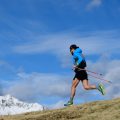Here’s what we know about the biological process of aging. As we age, our bodies undergo physiological changes that impact aerobic capacity and muscular strength.

Here’s what we commonly see as outcomes of aging in an increasingly sedentary American population: development of chronic diseases (e.g. cardiovascular disease, type 2 diabetes, obesity), degenerative musculoskeletal conditions (e.g. osteoporosis, arthritis, sarcopenia), and cognitive decline.
For a large swath of Americans living a sedentary lifestyle, these latter outcomes are coming to be seen as a “normal” part of aging.
However, as we know from cross-cultural comparisons and medical studies, these latter sets of outcomes are anything but an inevitable aspect of human aging. As underscored in the American College of Sports Medicine’s (ACSM) position stand on physical activity for older adults, “regular physical activity substantially modifies these risks” (Chodzko-Zajko et al. 2009).
Those of us who engage in multisport training and racing are more accustomed to seeing the alternative possibilities for aging. On any given weekend during the racing season, we routinely witness sexagenarians, septuagenarians and octogenarians swimming, biking and/or running around race courses.
Consider triathlete Madonna Buder who, at age 75, became the oldest woman to finish the Ironman World Championship in Hawaii. That was in 2005. A year later, she did it again at age 76. Buder has completed over 325 triathlons, including 45 Ironman-distance events, in her age-group triathlon career.
Last year, Harriet Anderson won the women’s 75 and over age-group at the Ironman World Championship in a time of 16 hours 56 minutes 1 second.
In the men’s race in Kona last year, Lew Hollander won the men’s 80 and over age-group by swimming the 2.4 miles in 1 hour 57 minutes 44 seconds, biking the 112 miles in 7:36:31, and running the 26.2 miles in 6:56:43. France Cokan and Lyle Roberts were close on his heels.
Or consider Ed Whitlock who, at age 70, clocked a sub 3 hour marathon and continues to set marathon records into his 80s.
But it’s not just the older athletes winning their age-groups and breaking world records that provide that crucial alternative vision of what “normal” aging might involve. It’s everyone who toes the starting line at a local weekend race as part of a commitment to living a healthy, active and fitness-oriented lifestyle.
Crucially, when it comes to aging, much of what is considered “normal” is socially and culturally defined. Beyond the primary effects of the aging process, many of the secondary aging effects that we all too often take for granted in American society can be substantially mitigated by healthy lifestyle choices.
As the ACSM summarizes (Chodzko-Zajko et al. 2009):
Although no amount of physical activity can stop the biological aging process, there is evidence that regular exercise can minimize the physiological effects of an otherwise sedentary lifestyle and increase active life expectancy by limiting the development and progression of chronic disease and disabling conditions. There is also emerging evidence for significant psychological and cognitive benefits accruing from regular exercise participation by older adults.
Yes, as noted in the last line above, exercise also holds important psychological and cognitive benefits for aging adults—a claim further evidenced by a recent article in the journal Medicine & Science in Sports & Exercise (Liu et al. 2012).
What’s “normal” for the aging process? Look to the everyday multisport athletes for the answer. Among them, you will find older adults who have seemingly discovered the fountain of youth as they enjoy a high quality of life well into their golden years. But one need not participate in Ironmans to gain these benefits—simply ensure that exercise remains a regular part of your life.







